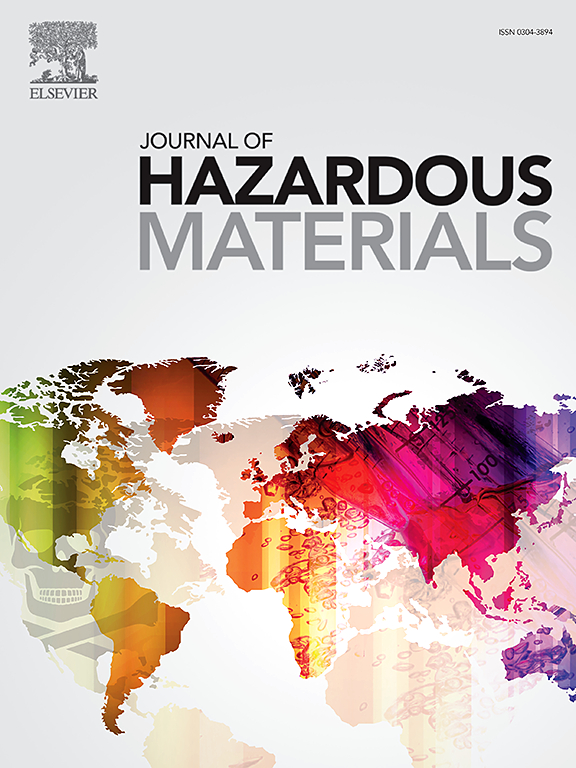粘土质沉积物压缩对中国沧州平原第四纪地下水系统氟富集的影响
IF 12.2
1区 环境科学与生态学
Q1 ENGINEERING, ENVIRONMENTAL
引用次数: 0
摘要
粘土层压缩对地下水氟化物富集的影响尚不清楚。沧州平原第四纪地下水氟化物含量较高,而沧州平原长期以来因粘土层挤压造成土地沉降,对健康构成潜在风险。通过样品采集、水化学分析和地球化学反演模型,确定了地下水氟化物的空间分布和富集机制。结果表明,在 122 个地下水样本中,82% 的样本氟化物浓度超过了中国饮用水 1.0 毫克/升的限值。浅层地下水(水深 20 米,平均 2.08 毫克/升)中的氟化物主要来源于萤石溶解,并受地下水 HCO3-HCO3-、pH 值和阳离子交换水平的影响。在 ~200 m 以下,地下水氟化物(~平均 = 3.12 mg/L)的主要来源是高 F- 浓度的粘土孔隙水的压缩释放,这是由复杂的水-岩相互作用产生的。根据水化学反演模拟和末端成员混合模型,粘土沉积释放的孔隙水供应了 53%-56% 的深层地下水(>200 m),对 F- 浓度的贡献为 2.07-2.87 mg/L。该研究结果为今后预防粘土质沉积物压缩诱发高氟地下水的研究提供了理论依据。本文章由计算机程序翻译,如有差异,请以英文原文为准。

Effect of clayey sediment compression on fluoride enrichment in the Quaternary groundwater system of Cangzhou Plain, China
The effect of clay layer compression on the enrichment of groundwater fluoride remains unknown. Quaternary groundwater with high fluoride levels at the Cangzhou Plain, which has a long history of land subsidence caused by clay layer compression, poses a potential health risk. The spatial distribution and enrichment mechanisms of groundwater fluoride are identified by sample collection, hydrochemical analysis, and geochemical inverse modeling. The results revealed that fluoride concentrations in 82% of the 122 groundwater samples above the limit in drinking water as 1.0 mg/L in China. Fluoride in shallow groundwater (depth 20 m, ~average = 2.08 mg/L) was mainly originated from fluorite dissolution and influenced by groundwater , pH, and cation exchange levels. Below ~200 m, the main source of groundwater fluoride (~average = 3.12 mg/L) was the compression−release of clay pore water with high F− concentration, which was generated by complex water-rock interaction. Based on hydrochemical inverse simulation and end-member mixing models, the pore water released from clayey sediments supplied 53%−56% of deep groundwater (>200 m) and contributed 2.07−2.87 mg/L to F− concentration. The findings of this study provide a theoretical basis for future research on prevention of high fluoride groundwater induced by clayey sediment compression.
求助全文
通过发布文献求助,成功后即可免费获取论文全文。
去求助
来源期刊

Journal of Hazardous Materials
工程技术-工程:环境
CiteScore
25.40
自引率
5.90%
发文量
3059
审稿时长
58 days
期刊介绍:
The Journal of Hazardous Materials serves as a global platform for promoting cutting-edge research in the field of Environmental Science and Engineering. Our publication features a wide range of articles, including full-length research papers, review articles, and perspectives, with the aim of enhancing our understanding of the dangers and risks associated with various materials concerning public health and the environment. It is important to note that the term "environmental contaminants" refers specifically to substances that pose hazardous effects through contamination, while excluding those that do not have such impacts on the environment or human health. Moreover, we emphasize the distinction between wastes and hazardous materials in order to provide further clarity on the scope of the journal. We have a keen interest in exploring specific compounds and microbial agents that have adverse effects on the environment.
 求助内容:
求助内容: 应助结果提醒方式:
应助结果提醒方式:


